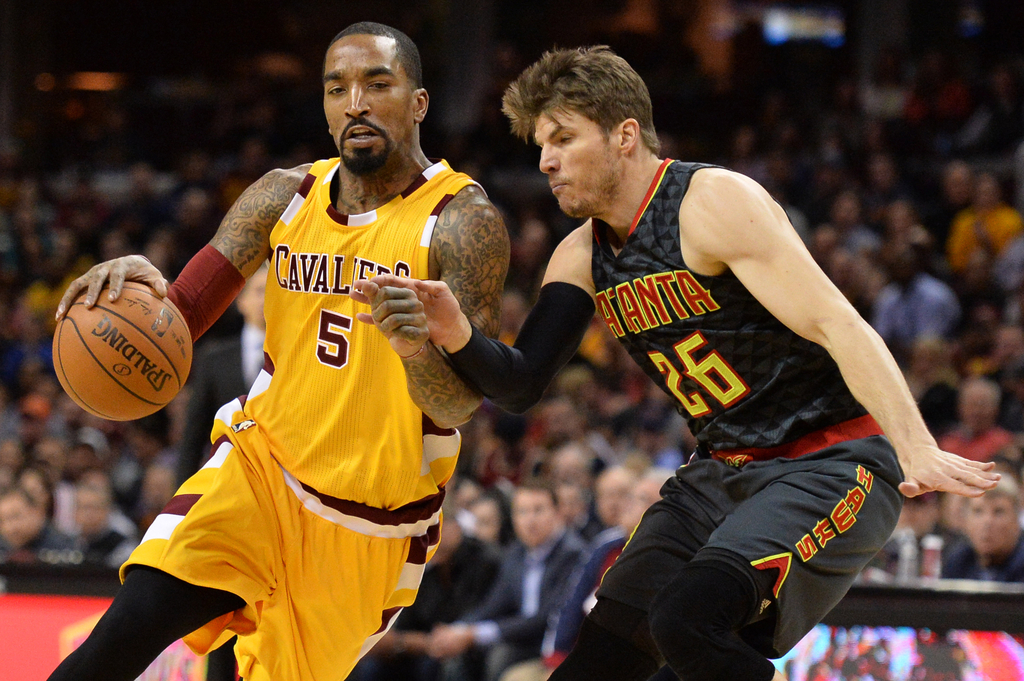
Korver Kalculus
2017-03-03https://www.youtube.com/watch?v=-GdG-KZxhes
It didn’t take long for Kyle Korver to make an impact, and he seems to be showing skills in areas even the most optimistic of Cavs fans were not expecting, such as positioning for boards — with a respectable 3.4 per game in February. The resurgence of the offense we’ve seen since the Kyle Korver trade is fueling the Cavs’ playoff odds, while revealing key information about the Cavs as a whole. The impact Kyle Korver has provided is evidence as to why having “Three Point Specialists” is integral to the franchise’s success, but will Korver continue to mesh when J.R. Smith returns? To explore this we need to see how the Cavs performed while lacking a mobile three point specialist, and explore the differences and similarities between both players. What will this all mean for the return of J.R? Are Smith, Korver, and the Cavs poised for some great basketball?
Replacing J.R. with Kyle and the January Blues
The struggles faced by the Cavs in January stood in stark contrast to their early season swagger. Any team struggling to play .500 ball while featuring LeBron James, Kyrie Irving, and Kevin Love is a team facing multiple issues. Some of these were apparent after digging into the statistics, while others were self-evident: the Cavs had a noticeable lack of movement and energy, and they looked like a team biding time for the playoffs. What catalysts triggered this slump? One thing that comes to mind is the fact that J.R. was injured December 20th. Following the injury, the Cavs kept humming along, even beating the Warriors on Christmas day. However, come January, the gears starting grinding to a halt, and a once unstoppable offensive juggernaut was stuck in the mud.
https://www.youtube.com/watch?v=OM8PRGWmkXE
The losses on Jan. 23rd to the the Anthony Davis -less Pelicans, and on the 25th to the Kings were particularly ‘brow-raising. The latter came despite Kyrie scoring 49, LeBron 26 and Love 22. You would rarely expect a loss when the big three perform this well. The fact is that January was a massive statistical outlier for the Cavs offense, with the team three point percentage dropping to 34.8 from 40 in December. January was a transition phase between losing a massive three point weapon (sometimes the third offensive threat when Love is cold or LeBron is resting) and gaining a new three point specialist who functions in a vastly different way. The Cavs need a mobile three point threat for their brand of basketball to function. Lebron the floor general thrives when perimeter players are in motion.
Korver was added on January seventh but was not getting the looks, the screens, or the sets he was accustomed to in Atlanta. The Hawks focused on setting screens for Korver. Atlanta, a real clinic in team ball, forced defenses into awkward rotations via constant ball movement and intelligent routes. The Hawks have also consistently been in the top 10 of pace, while the Cavs rank 18th. Needless to say, Korver could not mesh into a new team overnight. Towards the tail end of January, he began to get into the Cav’s rhythm.
As mentioned earlier, the Cavs, and especially LeBron, thrive with three point threats. Frye has been a fantastic weapon, and J.R.’s shooting was an underrated part of last summer’s game 7 victory. The role of a mobile three point threat creates enhanced ball movement and moves opposing defenders, allowing standstill catch-and-shoot players like Frye and Jefferson to get easier three looks off LeBron and Kyrie dimes, and simple ball movement. January was a nadir for team assists all season with just 20 per game compared to 25 per game in February. In February, as Korver got more comfortable, the Cavs produced season highs in assists per game, three point percentage, and points per game. The bounce back has been pretty remarkable when you consider that Kevin Love also joined J.R on the injured list.
Cavs Stats by Month:
Oh one more thing… Individually, Korver’s three point percentage went from 40 percent in January, to 60 percent in February. Praise Threezus!
Kyle and J.R. are both excellent three point shooters, but they play a very different game. Fortunately, Korver and Smith have enough key differences to keep defenses off-balance while still having enough similarities to allow the Cavs to operate smoothly if one subs in for the other. J.R smith often takes threes while covered, while slightly in motion, or off the dribble. J.R would often receive rhythm passes, pull up instantly, and swish – a strange rhythm that the Cavs as a unit had grown to understand.
Korver thrives at getting open without the ball: using his feet, feints, and changes of speed to move his defender around a wide variety of screens – to create shooting space and get to his “spots.” Kyle rarely dribbles after catching. Another key difference: Korver does poorly under tight coverage when compared to J.R. Chalk this up to J.R.’s ability to elevate higher and more quickly.
The Cavs filled the gap caused by Smith’s absence by acquiring somebody who serves the same role on offense in a different way. Comparing the 2015-2016 season for fuller percentage data it shows some stark differences.
J.R Smith Stats by Coverage (2017):

J.R shoots an amazing 42.5 percent when tightly covered (“0-2 Feet – Very Tight”) and 35.7% from three. He is at his absolutely best on wide open shots, with an effective field goal percentage of almost 65%.
Kyle Korver Stats by Coverage:
Conversely, Korver doesn’t like to be crowded, but seems to do better than Smith when defenders are “close” – between 2-6 feet, and is not nearly as good as J.R. when “Wide Open.”
On top of their coverage preferences, Korver and JR have a vast difference in abilities with the ball in their hands. Korver has averaged more than 70 percent of shots coming after no dribble throughout his career, while J.R dribbles more than once on 46% of his shots. There is no doubt that Korver is a more accurate shooter, but with the caveat that he must be open and prefers not to dribble. Offensively, Korver is more of a one trick pony than J.R averaging less than .1 points per drive per game for most of his career, while J.R averages 1.2 points per drive. The stats paint a comparison of J.R as a three point shooter who excels at giving a crossover or shooting over tight coverage versus Korver who is among the best in the business as an open spot up shooter and shooter off the screen. Despite these major differences in play style and coverage preferences, Korver still inherited J.R.’s perpetual green light.
Per CBS sports:
“Asked if he had any advice for the newcomer about playing with James, Love did not hesitate.
‘When you catch the ball, shoot it.’ “
As evidence of Korver’s comfort level, the percentage of shots where he held the ball for under two seconds has increased to 95% from 90% in January. Kyle is taking within offensive sets instead of freelancing on the catch-and shoot like J.R might have via his handle and athleticism.
Korver has started to settle in and take the shots that work for him, and has returned to the hot shooting he saw in the 2014-2015 season with Atlanta. His role, and his development in the system has revealed that the Cavs thrive when they have a mobile threat from three to bolster scoring, ball movement, and spacing. He has also show that the Cavs are able to adapt to a new member filling a crucial role in a relativity short amount of time. Transitioning to a primary shooter who would receive 32 percent of his looks off screens, from J.R who has received almost 16 percent of looks of screens is a big difference for a team and an individual to overcome. Check out the January/February splits. They’re eye opening.
In addition, his the array of skills he brought over from the Hawks such as passing IQ and an “always box out” rebounding mentality have been a bonus most of us weren’t expecting. He has also shown some good passing flare in the process, using his three point threat to often feed a slipping screener. The result? A whopping +5.7 per game in 27.6 minutes per night. With these numbers, Korver should be getting sixth man of the year consideration. Credit for integrating Kyle goes to Lue, Lebron’s ability to make people better, Cleveland’s championship chemistry, and, of course, Korver himself.
What happens when J.R. Comes back?
J.R. had not been shooting nearly as well as Korver over the last three seasons, so the addition of Korver as a floor spacer should only help. However, Smith was pretty hot from the corners before the injury, and they’ve both shown the ability to be very good shooters from all spots on the three point arc.
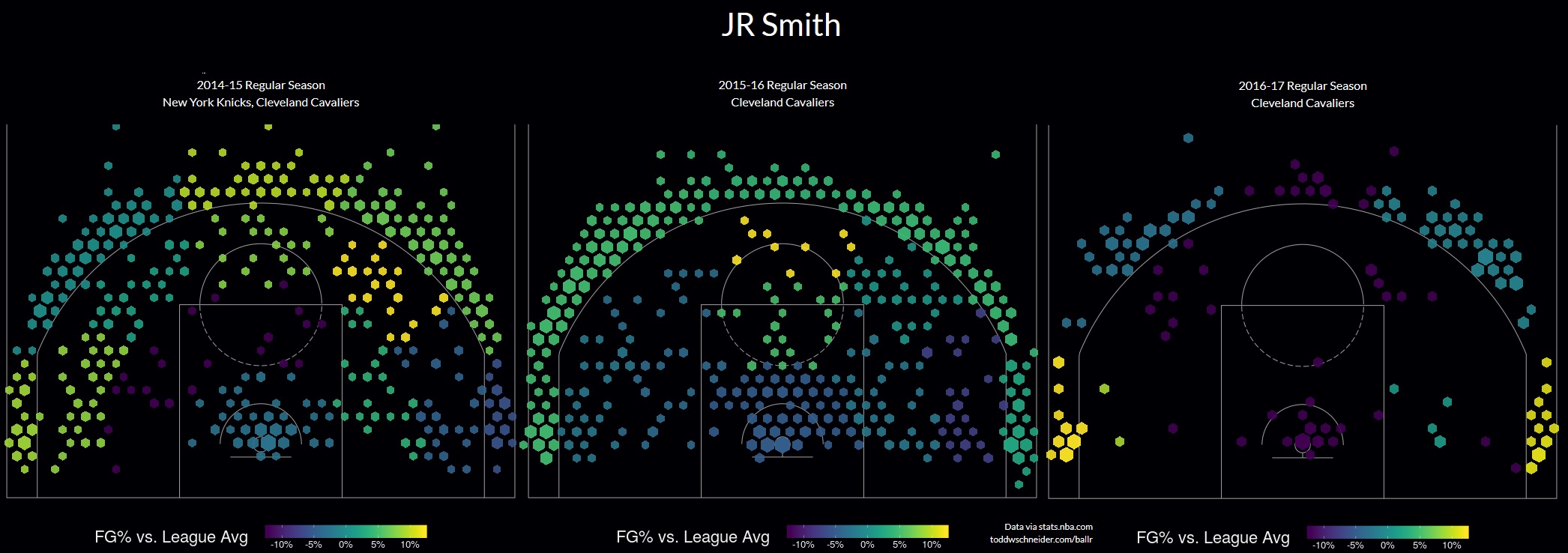
J.R has nothing to worry about. Kyle’s presence should should only lead to more tired legs guarding them both, if Lue manages rotations right. Korver’s constant motion, could both confuse defenders for J.R (due to play style difference) and physically exhaust them. I am hoping Lue uses J.R. and Threezus to bait defenders into overly aggressive perimeter defense, similar to the Steph effect of 2016.
When defenders overplay Smith, he should be able to get all the way to the rim given Cleveland’s other offensive threats. Much like Richard Jefferson, J.R’s 60 percent FG from within three feet only attests to the fact that when he does take it to the hole, he tends to get a bucket. This threat becomes even more exaggerated when the opposing team is forced to put their weakest defender on J.R due to Cleveland’s more other more potent scoring threats on the floor. Two man action with J.R. and Kyle should be a staple of the Cavs offense. They should mirror the two man action that Frye and Korver were flashing until last game. Unlike Korver, and Frye, though, J.R has dribbling skills and has explosiveness to more effectively punish defenders for overreaching. When he returns, Cleveland will have an embarrassment of shooting riches. Expect J.R’s shot chart to become increasingly brighter inside the paint and around the arc after his return and into next season.
J.R will have not only have more rest, but also be able to take advantage of not being the only sharpshooter positionally. J.R has shown the ability to be a good defender when locked in, and will hopefully be able to get stops and be a solid two-way player in the playoffs. If all goes well J.R can be primed for a triumphant return on both ends of the floor, a return with more offensive options, fresher legs, and higher stakes.
All Stats from
Shot chart info from
http://toddwschneider.com/posts/ballr-interactive-nba-shot-charts-with-r-and-shiny/



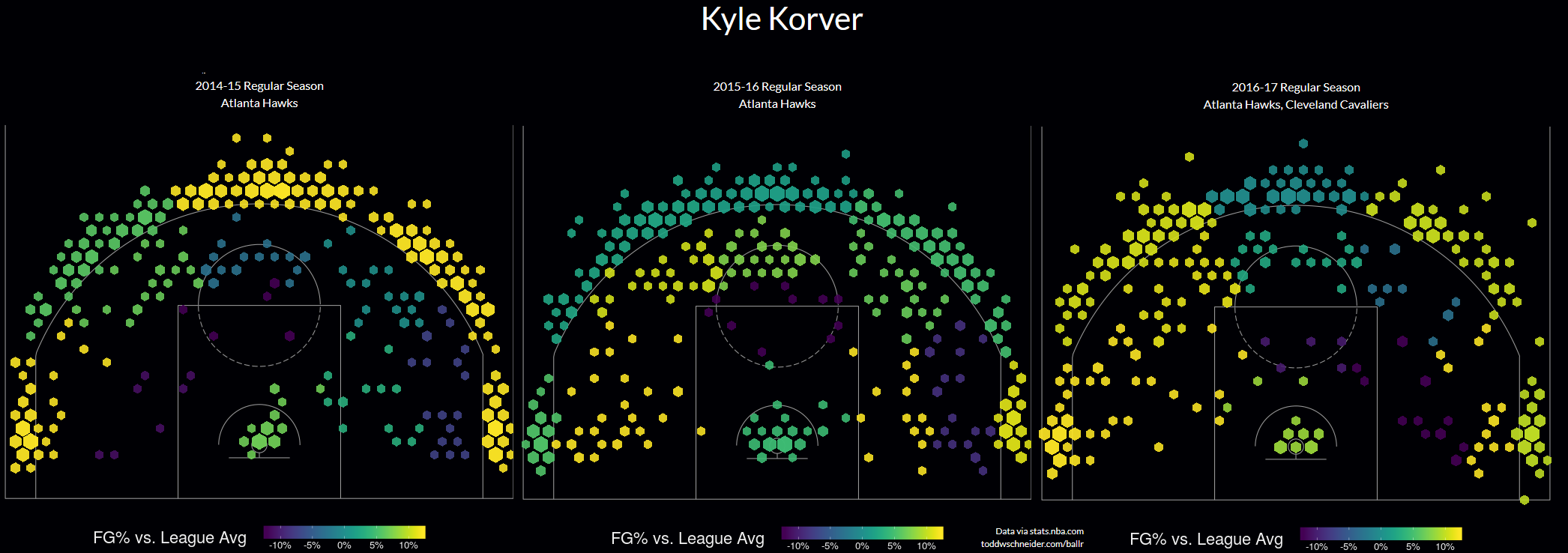

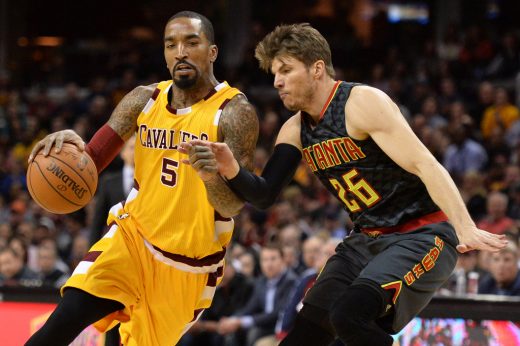
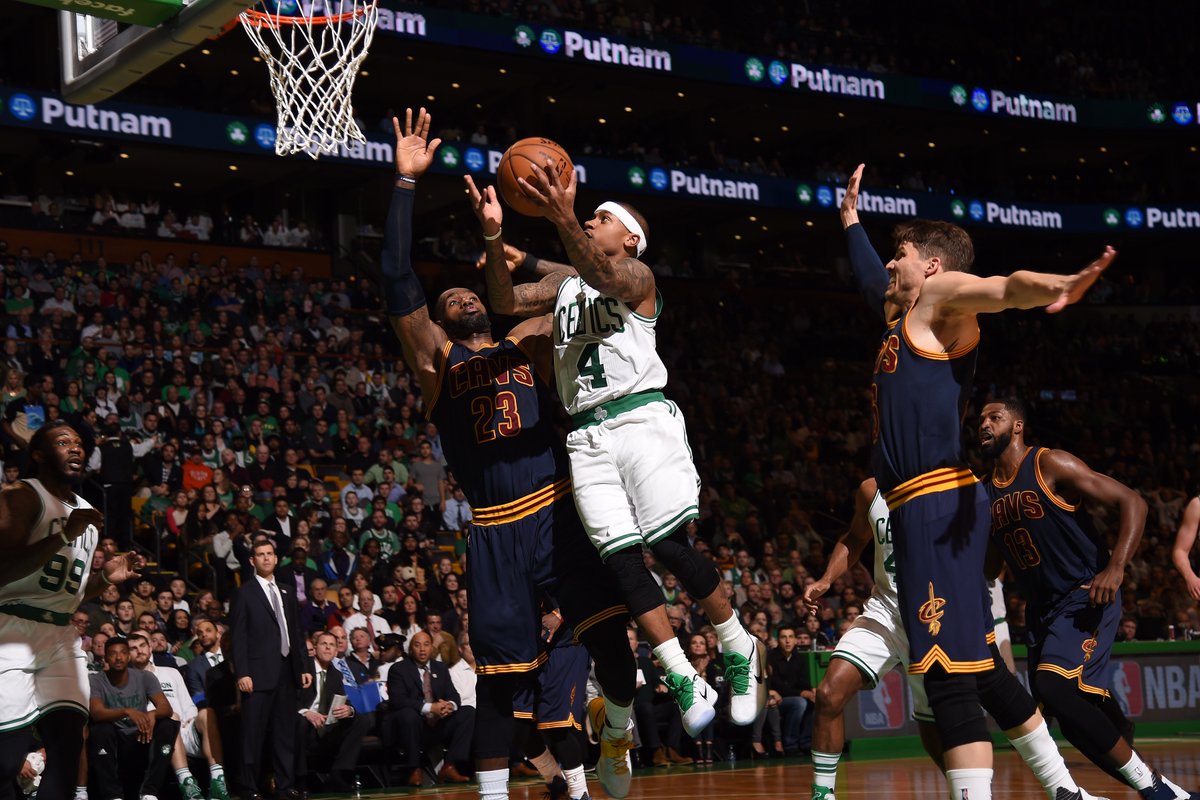

Pleasantly surprised by how well Korver has fit in. I thought Griffin might have acquired only a slight improvement over Dunleavy, and I really worried about KK’s defense (or lack thereof). And as you may recall, it didn’t start out so great. [Compare early contributions of Korver to those of the D-Willies, who cost a lot less.] But with some game time (and perhaps a practice or two), this has been a great acquisition!
Great analysis.
Great analysis. Very insightful.
Nice analysis, Mitch. JR was a game saver in Game 7 as you highlight. We went down 8 early in the third quarter, and I remember thinking whether the Dubs were getting ready to pull away. Then JR hits those back to back threes, and before that he had hit a two pointer. Those quick 8 pts by JR made the Block, Shot and Stop possible. And of course #23 assisted on both threes.
While this very in-depth blog in the differences between the shooting of these two very good NBA players is solely about shooting (btw, great article! A lot of meat for conversation.) I’d like to point out the differences in D with these two. JR as become a very good defensive player, can certainly man up on D and also does well on team D, but I was surprised on how well Korver acclimated to D. I guess a lot to do with being a veteran, but he seems to be in the right spot at the right time. I don’t… Read more »
I would almost prefer Bogut to start and let Frye get back to the bench role he was so good in earlier. I think we have seen that with Channing we have a case of diminishing returns. The more he has to bump and bruise in the starting lineup, the less he is able to do the things he is truly good at.
Agree with JMay.
Bogut can roll to the rim a bit better than Frye too. Cavs already have that capability because Thompson also does that so he should fit in quickly.
Frye may see reduced minutes but he will remain in the rotation. He allows a big lineup that spreads the floor for Bron and Kyrie’s slashing assaults.
The offensive sets I’ve drawn up in my head for a 5-man lineup of Kyrie, Korver, JR, Bron, and Love are just absolutely terrifying. They are downright impossible to defend.
Threeeeezus
Great article. I can’t wait to see JR back in action. With him and Love out it makes it puts a lot of pressure on Korver and Frye to hit threes and when they aren’t hitting we are slightly more mortal as we saw in the Celtics game.
I am beyond excited, who would have thought when we traded for J.R that someday ” we would miss his defense”.